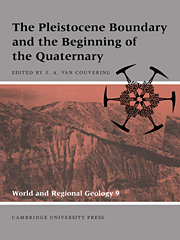Book contents
- Frontmatter
- Contents
- List of contributors
- Preface: the new Pleistocene
- Foreword
- Part I Definition of the base of the Quaternary
- Part II Characterization of the Pleistocene boundary-stratotype
- Part III The paleontological context of the Pleistocene boundary
- Part IV The Pleistocene boundary in regional sequences
- 11 The Pliocene–Pleistocene boundary in Italy
- 12 Stratigraphy of the Plio–Pleistocene sequence of the Mediterranean coastal belt of Israel and its implications for the evolution of the Nile Cone
- 13 The Pliocene–Pleistocene transition in the Iberian Peninsula
- 14 Biostratigraphy and calibrated climatic chronology of the Upper Pliocene and Lower Pleistocene of France
- 15 The Plio–Pleistocene of England and Iceland
- 16 The Neogene–Ouaternary boundary in The Netherlands
- 17 The Tertiary–Quaternary boundary in western Germany
- 18 The Pliocene–Pleistocene boundary in eastern Germany
- 19 The Plio–Pleistocene of Hungary
- 20 The Pliocene–Pleistocene boundary in Romania
- 21 The Pliocene and Pleistocene of the European part of the Commonwealth of Independent States
- 22 The N/Q boundary in Asian Russia and Tadjikistan
- 23 The Pliocene–Pleistocene boundary in the Indian subcontinent
- 24 The Pliocene–Pleistocene boundary in Japan: the Osaka Group, Kinki district
- 25 The Pliocene–Pleistocene boundary in Japan: stratigraphy in the Boso Peninsula, central Japan
- 26 The base of the Quaternary in China
- 27 Plio–Pleistocene deposits and the Quaternary boundary in sub-Saharan Africa
- 28 Plio–Pleistocene reference sections in Indonesia
- 29 The Pliocene–Pleistocene boundary in New Zealand
- 30 The Pliocene–Pleistocene boundary in continental sequences of North America
- Index
14 - Biostratigraphy and calibrated climatic chronology of the Upper Pliocene and Lower Pleistocene of France
Published online by Cambridge University Press: 10 November 2009
- Frontmatter
- Contents
- List of contributors
- Preface: the new Pleistocene
- Foreword
- Part I Definition of the base of the Quaternary
- Part II Characterization of the Pleistocene boundary-stratotype
- Part III The paleontological context of the Pleistocene boundary
- Part IV The Pleistocene boundary in regional sequences
- 11 The Pliocene–Pleistocene boundary in Italy
- 12 Stratigraphy of the Plio–Pleistocene sequence of the Mediterranean coastal belt of Israel and its implications for the evolution of the Nile Cone
- 13 The Pliocene–Pleistocene transition in the Iberian Peninsula
- 14 Biostratigraphy and calibrated climatic chronology of the Upper Pliocene and Lower Pleistocene of France
- 15 The Plio–Pleistocene of England and Iceland
- 16 The Neogene–Ouaternary boundary in The Netherlands
- 17 The Tertiary–Quaternary boundary in western Germany
- 18 The Pliocene–Pleistocene boundary in eastern Germany
- 19 The Plio–Pleistocene of Hungary
- 20 The Pliocene–Pleistocene boundary in Romania
- 21 The Pliocene and Pleistocene of the European part of the Commonwealth of Independent States
- 22 The N/Q boundary in Asian Russia and Tadjikistan
- 23 The Pliocene–Pleistocene boundary in the Indian subcontinent
- 24 The Pliocene–Pleistocene boundary in Japan: the Osaka Group, Kinki district
- 25 The Pliocene–Pleistocene boundary in Japan: stratigraphy in the Boso Peninsula, central Japan
- 26 The base of the Quaternary in China
- 27 Plio–Pleistocene deposits and the Quaternary boundary in sub-Saharan Africa
- 28 Plio–Pleistocene reference sections in Indonesia
- 29 The Pliocene–Pleistocene boundary in New Zealand
- 30 The Pliocene–Pleistocene boundary in continental sequences of North America
- Index
Summary
Introduction
In the years following the consensus on the Pliocene–Pleistocene boundary in France (Chaline and Michaux, 1972a) and the observation (Chaline, 1977) that the appearance of Allophaiomys pliocaenicus in European mammal faunas is synchronous with the Neogene–Quaternary boundary proposed by IGCP-41 at the top of the Olduvai event, there have been several further developments. In this chapter we review, in succession, the following: the new “rodent biostratigraphy” and the correlations that it implies; geochronologic data permitting new calibrations; new palynological and faunal data of significance for paleoclimatic correlations in northern Europe; and a reevaluation of the classic sites with respect to the Neogene–Quaternary boundary.
“Rodent biostratigraphy”
In the classic sites of Plio–Pleistocene age, the large mammals have provided the basis for a biostratigraphy that approaches a succession of assemblage-zones or cenozones. In practice, however, the true affiliations of the large mammal species from the various levels are seldom known for certain, because it is only rarely that sufficient numbers of individuals are found in a given assemblage to permit reliable determinations of the intraspecies and interspecies variations. The same is not true for rodents, which are notably very abundant in cave fillings, but can also occur in equal numbers in fluviolacustrine deposits. The best-documented rodent lineage in the interval under discussion is that which began with Mimomys occitanus, with seven species ranging from the middle Pliocene to middle Pleistocene (Chaline and Michaux, 1972a,b).
- Type
- Chapter
- Information
- The Pleistocene Boundary and the Beginning of the Quaternary , pp. 178 - 182Publisher: Cambridge University PressPrint publication year: 1996



